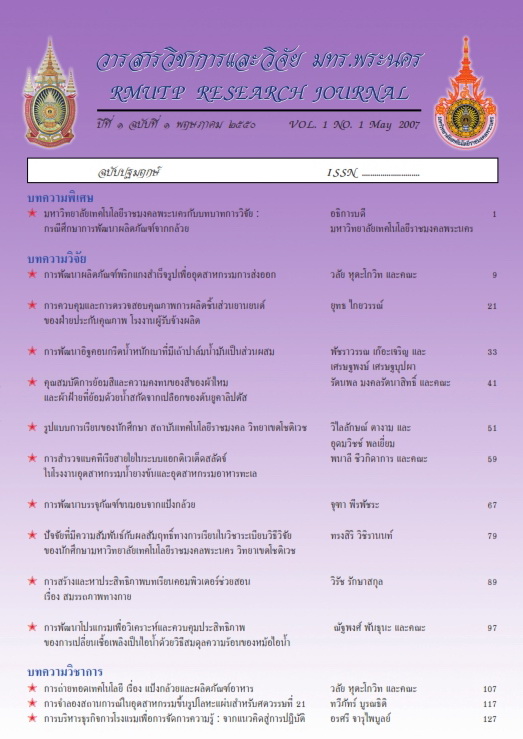การพัฒนาอิฐคอนกรีตน้ำหนักเบาที่มีเถ้าปาล์มน้ำมันเป็นส่วนผสม
Main Article Content
บทคัดย่อ
บทคัดย่อ
การศึกษาวิจัยนี้มีจุดประสงค์เพื่อหาส่วนผสมที่เหมาะสมของคอนกรีตที่มีเถ้าปาล์มเป็นส่วนผสม ที่จะสามารถนำไปผลิตอิฐคอนกรีตที่มีคุณสมบัติเทียบเท่าหรือดีกว่าวัสดุก่อผนังทั่วไป โดยใช้การทดลองปรับเปลี่ยนส่วนผสมระหว่างปูนซีเมนต์ทราย และเถ้าปาล์มน้ำมัน ผลการทดลองพบว่าส่วนผสมที่เหมาะสมระหว่างวัสดุทั้งสาม คือ 1:1:2 โดยน้ำหนักคอนกรีตที่ได้มีความหนาแน่นเฉลี่ย 766 กก./ลบ.ม. สามารถนำไปทำอิฐ คอนกรีตที่สามารถรับแรงอัดได้เฉลี่ยประมาณ 90 กก./ตร.ซม. สูงกว่ามาตรฐานผลิตภัณฑ์อุตสาหกรรม ฉบับ มอก. 58-2533 สำหรับคอนกรีตบล็อก มีค่าการดูดซึมน้ำ ร้อยละ 20 โดยน้ำหนัก ซึ่งอยู่ในเกณฑ์มาตรฐาน มีค่าการนำความร้อน 0.194 W/mK ซึ่งเทียบได้ใกล้เคียงกับอิฐมวลเบา แต่เมื่อนำไปก่อสร้างผนังแล้วมีราคาถูกกว่าอิฐ มวลเบาประมาณตารางเมตรละ 100 บาท ที่สำคัญคือสามารถผลิตได้ง่ายและสามารถส่งเสริมให้เป็นอุตสาหกรรมในท้องถิ่นได้
Abstract
The objective of this research was to find an appropriate mixing ratio of concrete with oil palm to produce concrete masonry units with properties equivalent or better than other conventional masonry materials. By trying out method, the best proportion of Portland cement: sand: oil palm ash was found at 1:1:2 by weight. The ratio yielded a lightweight concrete with an average density of 766 kg/m3, and average compressive strength of approximately 90 kg/ cm2, which is higher than the minimum requirement of Thai Industrial Standards (TIS) 582533 (1990) of 75 kg/cm2. Water absorption of this proportion was at an acceptable standard level of 20 °/o by weight. From cost analysis, the cost of a wall made with the obtained masonry units was about 100 baht per square meter cheaper than lightweight masonry units sold in the market. However, the heat conductivity (K) was similar (0.194 W/mk). Moreover, the manufacturing process of these masonry units is simple and can be run as a small local enterprise.


